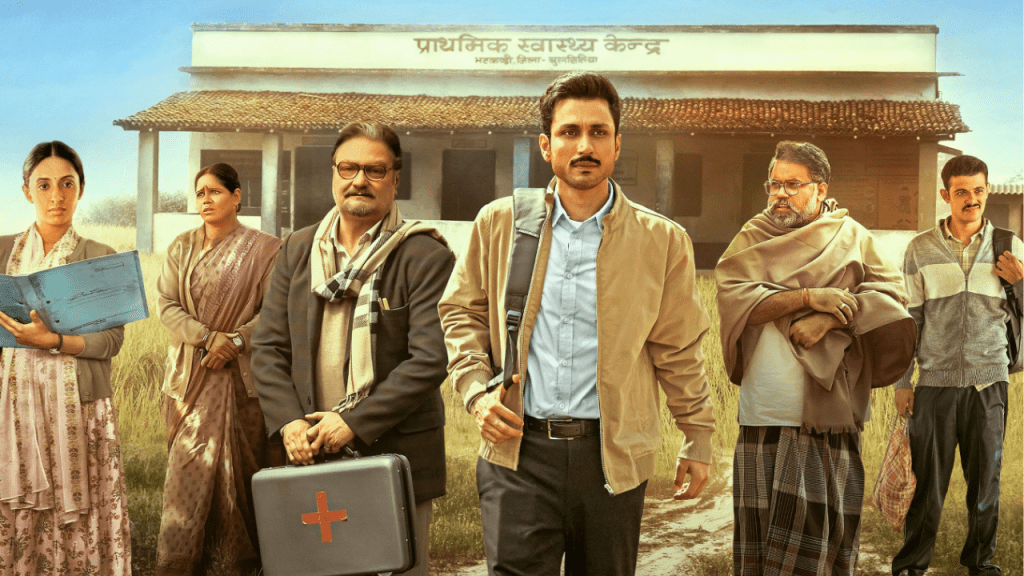Language: Hindi
Age Rating: UA (Suitable for viewers above 13 years)
Genre: Drama, Social Commentary
Streaming on: Prime Video
A Rural Saga That Blends Humor, Hope, and Healthcare Gaps
Gram Chikitsalay is a warm, grounded series that peels back the layers of rural India’s neglected healthcare system. Created by TVF, the show is set in a fictional village in Jharkhand and introduces us to the world of Dr. Prabhat Sinha—an idealistic government doctor trying to bring real change to a community deeply rooted in its own ways.
Must Read: Gram Chikitsalay Trailer Review: Amol Parashar Brings Wit & Warmth to Rural Healthcare
Through humor, emotional moments, and sharp observations, the show explores the tension between modern medicine and entrenched beliefs. It’s a tale of hope versus habit, portrayed with TVF’s signature storytelling sincerity.
Performances: Amol Parashar is the Beating Heart of Bhatkandi
Amol Parashar brings depth and earnestness to his role as Dr. Prabhat Sinha. A gold medalist from a reputed medical college, Prabhat chooses to serve in the grassroots and finds himself up against not just a broken system but also the villagers’ unwavering faith in a local quack, Chetak Kumar.
Vinay Pathak is excellent as the dubious “doctor” who administers boosters for everything from cold to grief. His charm is dangerous, yet believable—and that’s where the brilliance lies. The contrast between Parashar’s restrained professionalism and Pathak’s casual confidence adds drama to the series in a subtle yet effective way.
Check Out: Panchayat Meets Gram Chikitsalay: Banrakas Visits Dr. Prabhat in a Hilarious Promo Crossover
Supporting actors like Anandeshwar Dwivedi (compounder Phutani), Akash Makhija (ward boy Gobind), and Garima Singh (nurse Indu) enrich the narrative with authenticity and warmth.
Direction, Visuals & Rural Authenticity
Director Rahul Pandey keeps the tone simple and grounded. There are no flashy camera tricks or overdone dramatics—just a sincere lens capturing the day-to-day trials of a village clinic. The setting of Bhatkandi, with its lush fields and muddy trails, becomes a character in itself. It reflects both beauty and adversity—mirroring the very challenges the doctor must navigate.
Like Panchayat and Gullak, the series relies on minimalism. The emotional beats are subtle. The humor is understated. And the heartbreaks, though soft, hit hard.
Check Out: Gram Chikitsalay Release Date Announced: Amol Parashar Leads Heartwarming Series on Rural Healthcare
Strengths and Shortcomings
What Works:
- Amol Parashar’s Performance: His portrayal of Dr. Prabhat is both layered and relatable.
- Grounded Storytelling: The rural backdrop and the realism of the healthcare scenario feel authentic.
- Strong Ensemble Cast: Every supporting role adds flavor to the village’s narrative.
- Social Commentary: The series gently questions blind faith, bureaucracy, and the cost of change.
Where It Falters:
- Lack of Dramatic Highs: While the narrative is touching, it lacks moments of strong tension or surprise.
- Slow Pacing: Some episodes meander, especially in the middle.
- Underdeveloped Subplots: Characters like Dr. Gargi (Akansha Ranjan) show promise but don’t get enough screen time—yet.
Final Verdict: ⭐️⭐️⭐️⭐️ (4/5)
Gram Chikitsalay is a tender, thought-provoking series with its heart in the right place. It doesn’t try to be overly dramatic, and in that simplicity lies its strength. While it could have benefited from more emotional highs and stronger conflicts, the show succeeds in creating a vivid, meaningful picture of rural healthcare in India.
It’s a slow-burn series, best watched patiently. And by the end, it leaves you with a lump in your throat and a sense of admiration for those who fight silent battles to make a difference.
Should You Watch It?
Yes—especially if you’re a fan of socially driven stories like Panchayat or Gullak. Gram Chikitsalay isn’t just a show about a doctor. It’s a reflection of India’s grassroots struggles, told with charm, humor, and hope.

